Marketing Strategy Report: Analysis of Nike's Marketing Approaches
VerifiedAdded on 2020/07/22
|18
|5123
|55
Report
AI Summary
This report presents a comprehensive analysis of Nike's marketing strategies, beginning with an introduction to marketing's role in business success. Part 1 delves into a situational analysis, employing SWOT and PESTEL frameworks to evaluate Nike's internal and external environments. It identifies strengths, weaknesses, opportunities, and threats, alongside political, economic, social, technological, ecological, and legal factors influencing the company. The report then examines Nike's competitive advantage, highlighting its strong brand image, product innovation (e.g., Flyknit), and unique selling propositions. The evaluation of the current marketing strategy showcases Nike's emphasis on brand image, storytelling, social consciousness, social media marketing, constant innovation, and effective advertising. The report concludes by analyzing the company's financial performance, demonstrating the effectiveness of its marketing efforts. Part 2 focuses on segmentation, targeting, and positioning for a selected sub-brand, recommending objectives and goals. Finally, marketing strategies based on the marketing mix are suggested, offering a complete overview of Nike's marketing approaches and their impact on its success in the footwear industry.

MARKETING
STRATEGY
STRATEGY
Paraphrase This Document
Need a fresh take? Get an instant paraphrase of this document with our AI Paraphraser

TABLE OF CONTENTS
INTRODUCTION ..........................................................................................................................1
PART 1............................................................................................................................................1
Situational analysis.....................................................................................................................1
Competitive Advantage...............................................................................................................6
Evaluation of current marketing strategy....................................................................................7
PART 2 .........................................................................................................................................10
Segmentation, Targeting and Positioning.................................................................................10
Recommended objectives and goals.........................................................................................12
Recommendations of the marketing strategies based on the marketing mix of Nike...............13
CONCLUSIONS............................................................................................................................16
REFERENCES..............................................................................................................................17
INTRODUCTION ..........................................................................................................................1
PART 1............................................................................................................................................1
Situational analysis.....................................................................................................................1
Competitive Advantage...............................................................................................................6
Evaluation of current marketing strategy....................................................................................7
PART 2 .........................................................................................................................................10
Segmentation, Targeting and Positioning.................................................................................10
Recommended objectives and goals.........................................................................................12
Recommendations of the marketing strategies based on the marketing mix of Nike...............13
CONCLUSIONS............................................................................................................................16
REFERENCES..............................................................................................................................17
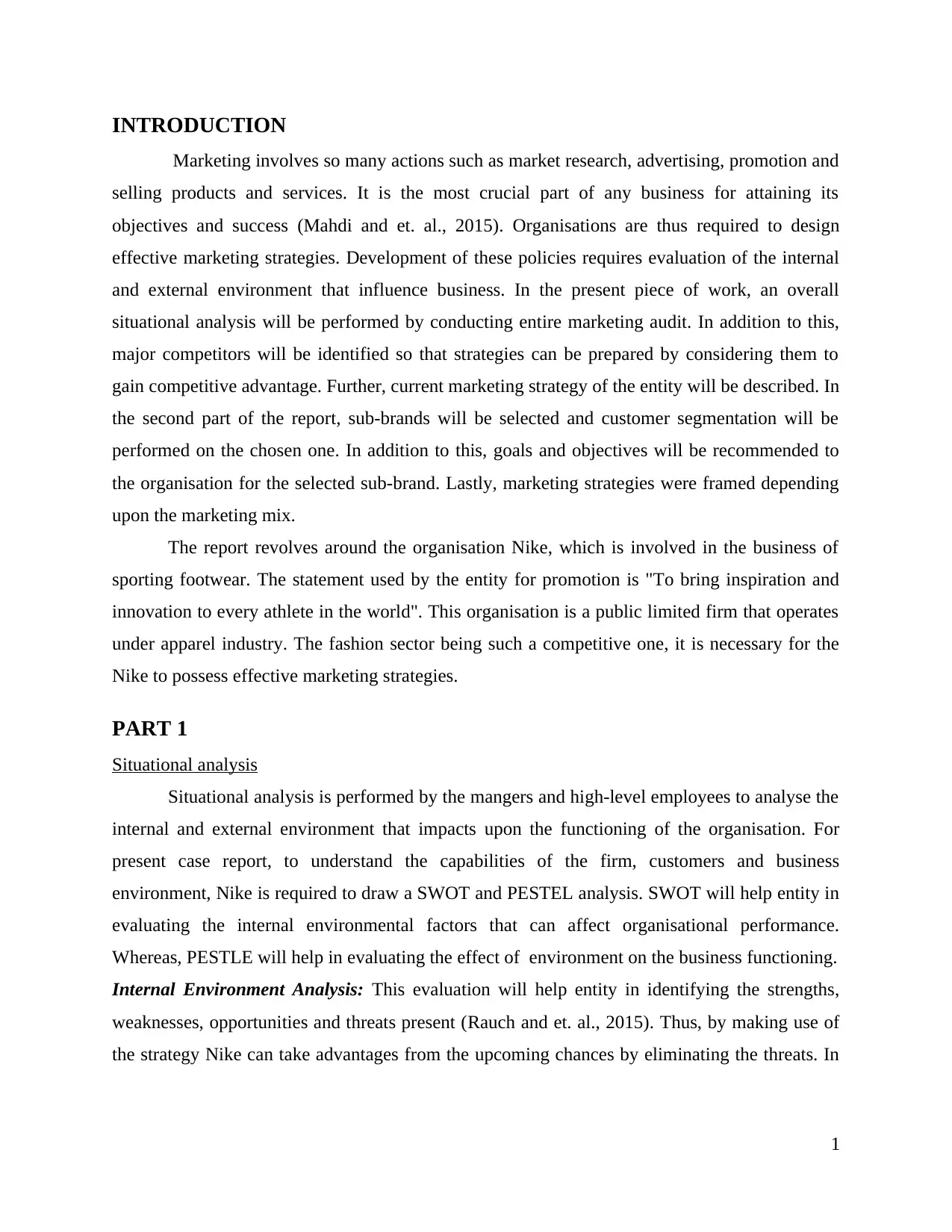
INTRODUCTION
Marketing involves so many actions such as market research, advertising, promotion and
selling products and services. It is the most crucial part of any business for attaining its
objectives and success (Mahdi and et. al., 2015). Organisations are thus required to design
effective marketing strategies. Development of these policies requires evaluation of the internal
and external environment that influence business. In the present piece of work, an overall
situational analysis will be performed by conducting entire marketing audit. In addition to this,
major competitors will be identified so that strategies can be prepared by considering them to
gain competitive advantage. Further, current marketing strategy of the entity will be described. In
the second part of the report, sub-brands will be selected and customer segmentation will be
performed on the chosen one. In addition to this, goals and objectives will be recommended to
the organisation for the selected sub-brand. Lastly, marketing strategies were framed depending
upon the marketing mix.
The report revolves around the organisation Nike, which is involved in the business of
sporting footwear. The statement used by the entity for promotion is "To bring inspiration and
innovation to every athlete in the world". This organisation is a public limited firm that operates
under apparel industry. The fashion sector being such a competitive one, it is necessary for the
Nike to possess effective marketing strategies.
PART 1
Situational analysis
Situational analysis is performed by the mangers and high-level employees to analyse the
internal and external environment that impacts upon the functioning of the organisation. For
present case report, to understand the capabilities of the firm, customers and business
environment, Nike is required to draw a SWOT and PESTEL analysis. SWOT will help entity in
evaluating the internal environmental factors that can affect organisational performance.
Whereas, PESTLE will help in evaluating the effect of environment on the business functioning.
Internal Environment Analysis: This evaluation will help entity in identifying the strengths,
weaknesses, opportunities and threats present (Rauch and et. al., 2015). Thus, by making use of
the strategy Nike can take advantages from the upcoming chances by eliminating the threats. In
1
Marketing involves so many actions such as market research, advertising, promotion and
selling products and services. It is the most crucial part of any business for attaining its
objectives and success (Mahdi and et. al., 2015). Organisations are thus required to design
effective marketing strategies. Development of these policies requires evaluation of the internal
and external environment that influence business. In the present piece of work, an overall
situational analysis will be performed by conducting entire marketing audit. In addition to this,
major competitors will be identified so that strategies can be prepared by considering them to
gain competitive advantage. Further, current marketing strategy of the entity will be described. In
the second part of the report, sub-brands will be selected and customer segmentation will be
performed on the chosen one. In addition to this, goals and objectives will be recommended to
the organisation for the selected sub-brand. Lastly, marketing strategies were framed depending
upon the marketing mix.
The report revolves around the organisation Nike, which is involved in the business of
sporting footwear. The statement used by the entity for promotion is "To bring inspiration and
innovation to every athlete in the world". This organisation is a public limited firm that operates
under apparel industry. The fashion sector being such a competitive one, it is necessary for the
Nike to possess effective marketing strategies.
PART 1
Situational analysis
Situational analysis is performed by the mangers and high-level employees to analyse the
internal and external environment that impacts upon the functioning of the organisation. For
present case report, to understand the capabilities of the firm, customers and business
environment, Nike is required to draw a SWOT and PESTEL analysis. SWOT will help entity in
evaluating the internal environmental factors that can affect organisational performance.
Whereas, PESTLE will help in evaluating the effect of environment on the business functioning.
Internal Environment Analysis: This evaluation will help entity in identifying the strengths,
weaknesses, opportunities and threats present (Rauch and et. al., 2015). Thus, by making use of
the strategy Nike can take advantages from the upcoming chances by eliminating the threats. In
1
⊘ This is a preview!⊘
Do you want full access?
Subscribe today to unlock all pages.

Trusted by 1+ million students worldwide
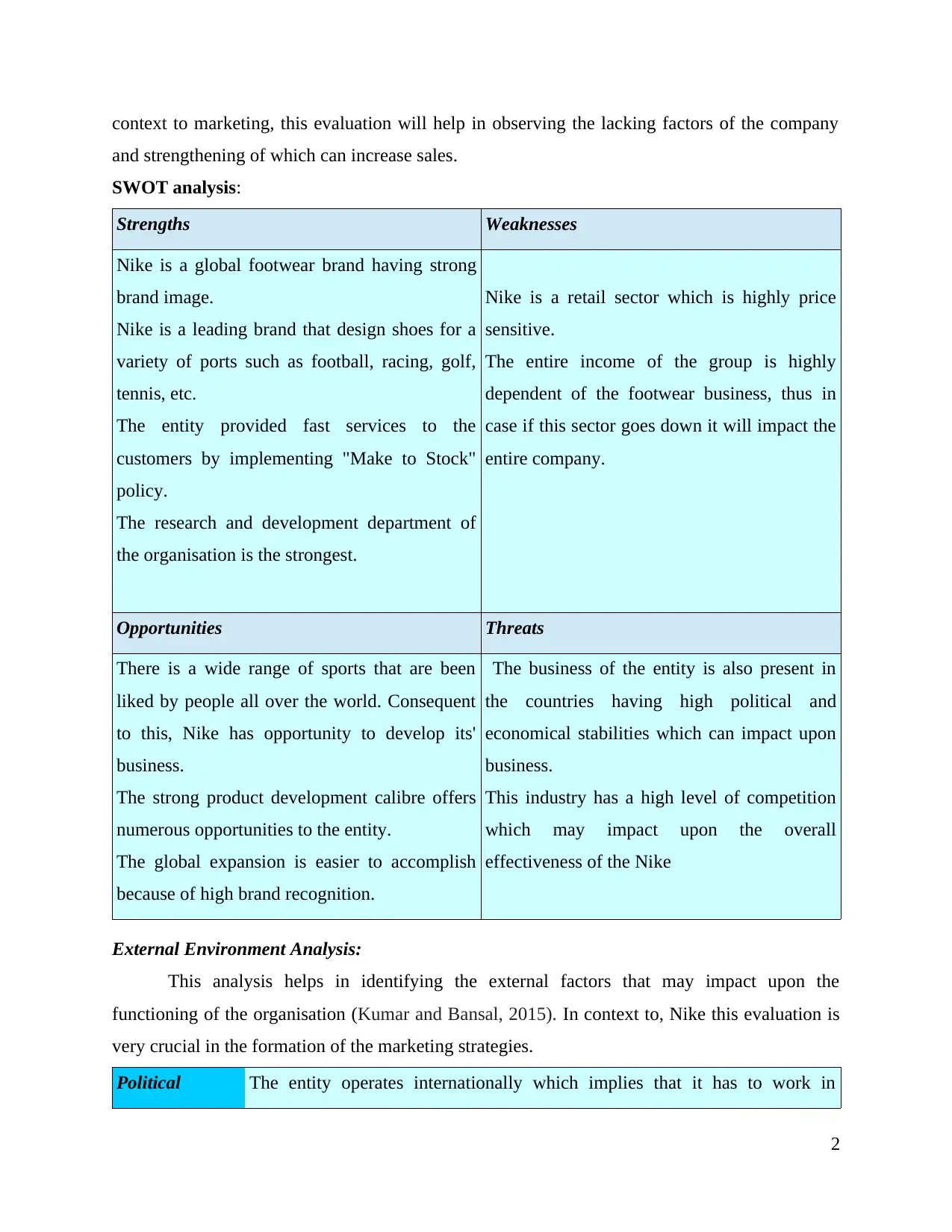
context to marketing, this evaluation will help in observing the lacking factors of the company
and strengthening of which can increase sales.
SWOT analysis:
Strengths Weaknesses
Nike is a global footwear brand having strong
brand image.
Nike is a leading brand that design shoes for a
variety of ports such as football, racing, golf,
tennis, etc.
The entity provided fast services to the
customers by implementing "Make to Stock"
policy.
The research and development department of
the organisation is the strongest.
Nike is a retail sector which is highly price
sensitive.
The entire income of the group is highly
dependent of the footwear business, thus in
case if this sector goes down it will impact the
entire company.
Opportunities Threats
There is a wide range of sports that are been
liked by people all over the world. Consequent
to this, Nike has opportunity to develop its'
business.
The strong product development calibre offers
numerous opportunities to the entity.
The global expansion is easier to accomplish
because of high brand recognition.
The business of the entity is also present in
the countries having high political and
economical stabilities which can impact upon
business.
This industry has a high level of competition
which may impact upon the overall
effectiveness of the Nike
External Environment Analysis:
This analysis helps in identifying the external factors that may impact upon the
functioning of the organisation (Kumar and Bansal, 2015). In context to, Nike this evaluation is
very crucial in the formation of the marketing strategies.
Political The entity operates internationally which implies that it has to work in
2
and strengthening of which can increase sales.
SWOT analysis:
Strengths Weaknesses
Nike is a global footwear brand having strong
brand image.
Nike is a leading brand that design shoes for a
variety of ports such as football, racing, golf,
tennis, etc.
The entity provided fast services to the
customers by implementing "Make to Stock"
policy.
The research and development department of
the organisation is the strongest.
Nike is a retail sector which is highly price
sensitive.
The entire income of the group is highly
dependent of the footwear business, thus in
case if this sector goes down it will impact the
entire company.
Opportunities Threats
There is a wide range of sports that are been
liked by people all over the world. Consequent
to this, Nike has opportunity to develop its'
business.
The strong product development calibre offers
numerous opportunities to the entity.
The global expansion is easier to accomplish
because of high brand recognition.
The business of the entity is also present in
the countries having high political and
economical stabilities which can impact upon
business.
This industry has a high level of competition
which may impact upon the overall
effectiveness of the Nike
External Environment Analysis:
This analysis helps in identifying the external factors that may impact upon the
functioning of the organisation (Kumar and Bansal, 2015). In context to, Nike this evaluation is
very crucial in the formation of the marketing strategies.
Political The entity operates internationally which implies that it has to work in
2
Paraphrase This Document
Need a fresh take? Get an instant paraphrase of this document with our AI Paraphraser
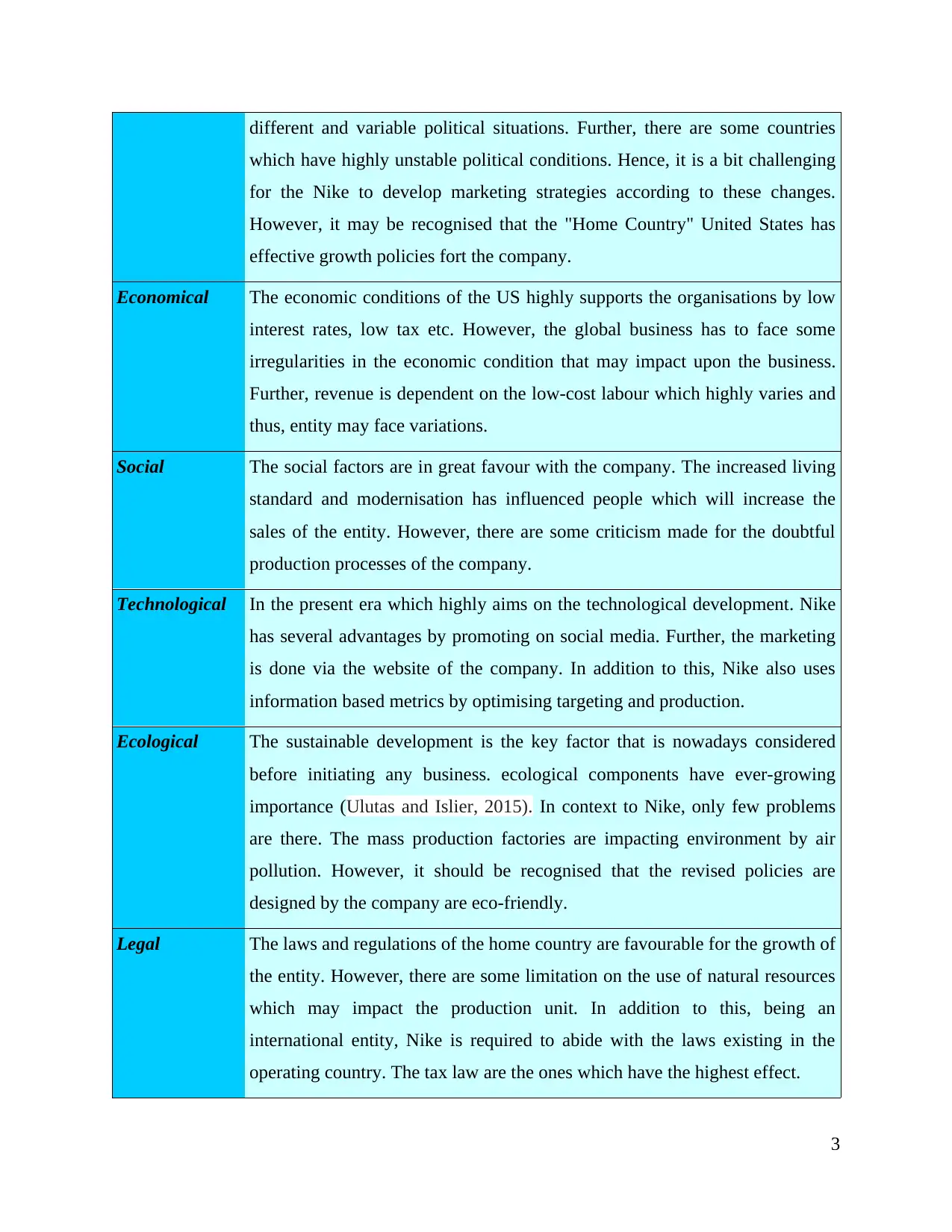
different and variable political situations. Further, there are some countries
which have highly unstable political conditions. Hence, it is a bit challenging
for the Nike to develop marketing strategies according to these changes.
However, it may be recognised that the "Home Country" United States has
effective growth policies fort the company.
Economical The economic conditions of the US highly supports the organisations by low
interest rates, low tax etc. However, the global business has to face some
irregularities in the economic condition that may impact upon the business.
Further, revenue is dependent on the low-cost labour which highly varies and
thus, entity may face variations.
Social The social factors are in great favour with the company. The increased living
standard and modernisation has influenced people which will increase the
sales of the entity. However, there are some criticism made for the doubtful
production processes of the company.
Technological In the present era which highly aims on the technological development. Nike
has several advantages by promoting on social media. Further, the marketing
is done via the website of the company. In addition to this, Nike also uses
information based metrics by optimising targeting and production.
Ecological The sustainable development is the key factor that is nowadays considered
before initiating any business. ecological components have ever-growing
importance (Ulutas and Islier, 2015). In context to Nike, only few problems
are there. The mass production factories are impacting environment by air
pollution. However, it should be recognised that the revised policies are
designed by the company are eco-friendly.
Legal The laws and regulations of the home country are favourable for the growth of
the entity. However, there are some limitation on the use of natural resources
which may impact the production unit. In addition to this, being an
international entity, Nike is required to abide with the laws existing in the
operating country. The tax law are the ones which have the highest effect.
3
which have highly unstable political conditions. Hence, it is a bit challenging
for the Nike to develop marketing strategies according to these changes.
However, it may be recognised that the "Home Country" United States has
effective growth policies fort the company.
Economical The economic conditions of the US highly supports the organisations by low
interest rates, low tax etc. However, the global business has to face some
irregularities in the economic condition that may impact upon the business.
Further, revenue is dependent on the low-cost labour which highly varies and
thus, entity may face variations.
Social The social factors are in great favour with the company. The increased living
standard and modernisation has influenced people which will increase the
sales of the entity. However, there are some criticism made for the doubtful
production processes of the company.
Technological In the present era which highly aims on the technological development. Nike
has several advantages by promoting on social media. Further, the marketing
is done via the website of the company. In addition to this, Nike also uses
information based metrics by optimising targeting and production.
Ecological The sustainable development is the key factor that is nowadays considered
before initiating any business. ecological components have ever-growing
importance (Ulutas and Islier, 2015). In context to Nike, only few problems
are there. The mass production factories are impacting environment by air
pollution. However, it should be recognised that the revised policies are
designed by the company are eco-friendly.
Legal The laws and regulations of the home country are favourable for the growth of
the entity. However, there are some limitation on the use of natural resources
which may impact the production unit. In addition to this, being an
international entity, Nike is required to abide with the laws existing in the
operating country. The tax law are the ones which have the highest effect.
3
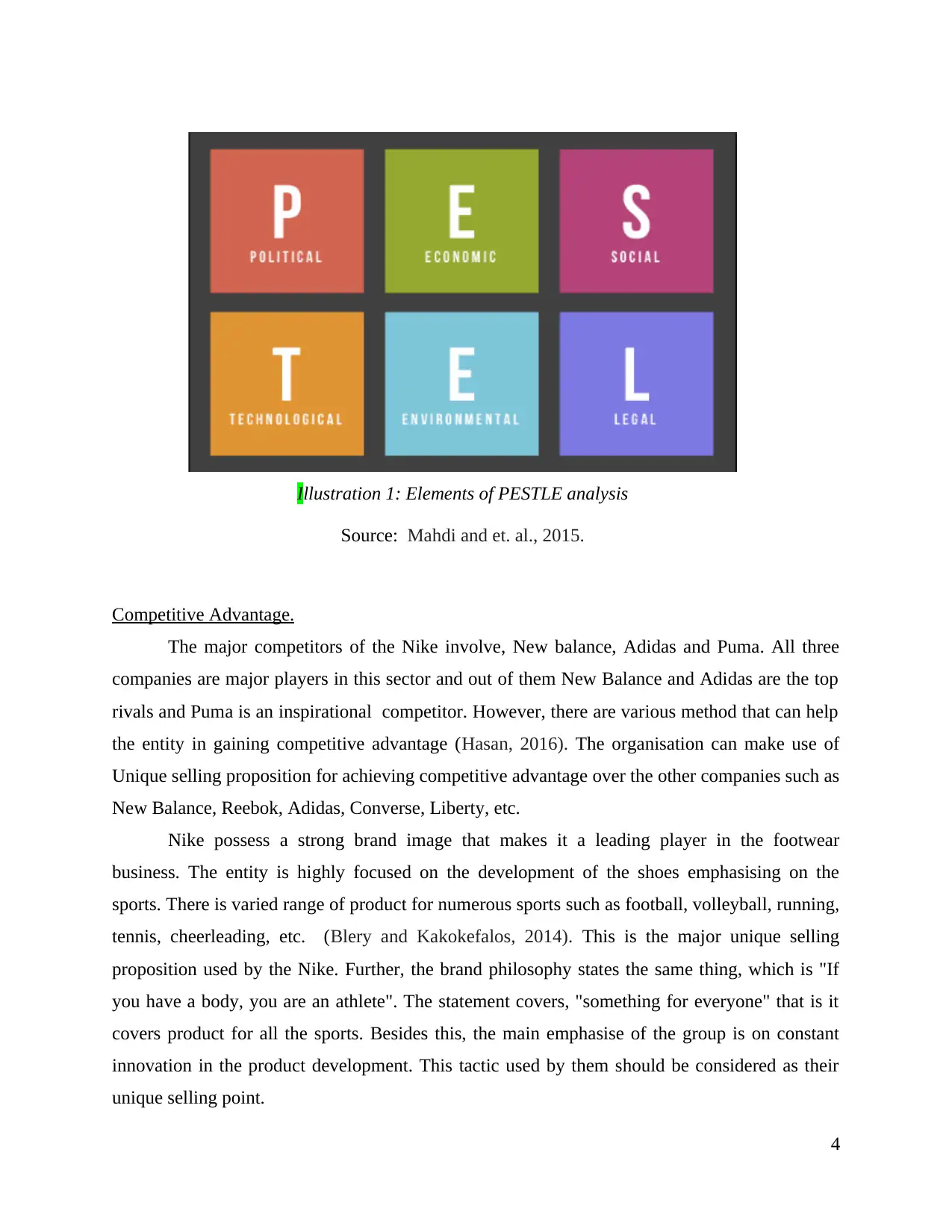
Competitive Advantage.
The major competitors of the Nike involve, New balance, Adidas and Puma. All three
companies are major players in this sector and out of them New Balance and Adidas are the top
rivals and Puma is an inspirational competitor. However, there are various method that can help
the entity in gaining competitive advantage (Hasan, 2016). The organisation can make use of
Unique selling proposition for achieving competitive advantage over the other companies such as
New Balance, Reebok, Adidas, Converse, Liberty, etc.
Nike possess a strong brand image that makes it a leading player in the footwear
business. The entity is highly focused on the development of the shoes emphasising on the
sports. There is varied range of product for numerous sports such as football, volleyball, running,
tennis, cheerleading, etc. (Blery and Kakokefalos, 2014). This is the major unique selling
proposition used by the Nike. Further, the brand philosophy states the same thing, which is "If
you have a body, you are an athlete". The statement covers, "something for everyone" that is it
covers product for all the sports. Besides this, the main emphasise of the group is on constant
innovation in the product development. This tactic used by them should be considered as their
unique selling point.
4
Illustration 1: Elements of PESTLE analysis
Source: Mahdi and et. al., 2015.
The major competitors of the Nike involve, New balance, Adidas and Puma. All three
companies are major players in this sector and out of them New Balance and Adidas are the top
rivals and Puma is an inspirational competitor. However, there are various method that can help
the entity in gaining competitive advantage (Hasan, 2016). The organisation can make use of
Unique selling proposition for achieving competitive advantage over the other companies such as
New Balance, Reebok, Adidas, Converse, Liberty, etc.
Nike possess a strong brand image that makes it a leading player in the footwear
business. The entity is highly focused on the development of the shoes emphasising on the
sports. There is varied range of product for numerous sports such as football, volleyball, running,
tennis, cheerleading, etc. (Blery and Kakokefalos, 2014). This is the major unique selling
proposition used by the Nike. Further, the brand philosophy states the same thing, which is "If
you have a body, you are an athlete". The statement covers, "something for everyone" that is it
covers product for all the sports. Besides this, the main emphasise of the group is on constant
innovation in the product development. This tactic used by them should be considered as their
unique selling point.
4
Illustration 1: Elements of PESTLE analysis
Source: Mahdi and et. al., 2015.
⊘ This is a preview!⊘
Do you want full access?
Subscribe today to unlock all pages.

Trusted by 1+ million students worldwide
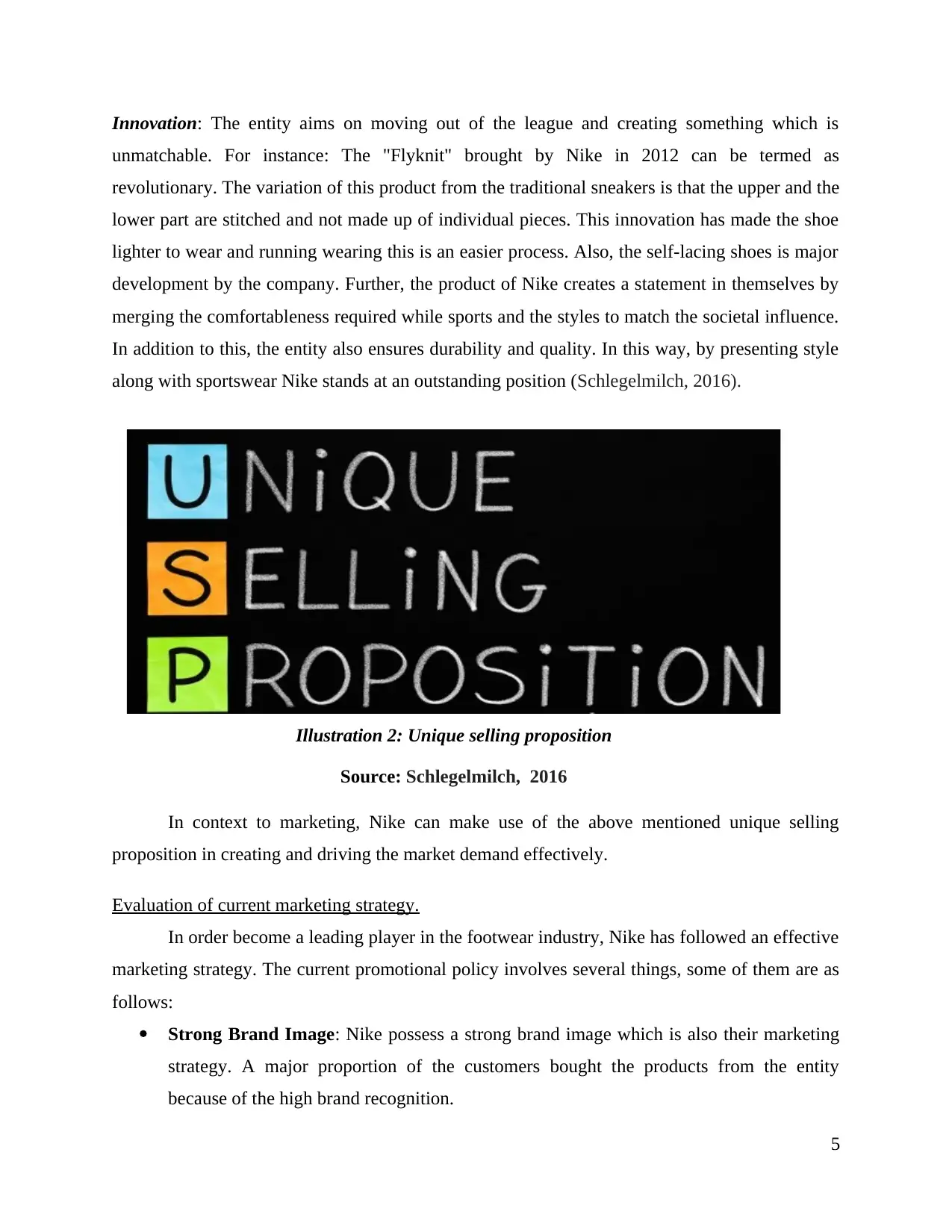
Innovation: The entity aims on moving out of the league and creating something which is
unmatchable. For instance: The "Flyknit" brought by Nike in 2012 can be termed as
revolutionary. The variation of this product from the traditional sneakers is that the upper and the
lower part are stitched and not made up of individual pieces. This innovation has made the shoe
lighter to wear and running wearing this is an easier process. Also, the self-lacing shoes is major
development by the company. Further, the product of Nike creates a statement in themselves by
merging the comfortableness required while sports and the styles to match the societal influence.
In addition to this, the entity also ensures durability and quality. In this way, by presenting style
along with sportswear Nike stands at an outstanding position (Schlegelmilch, 2016).
In context to marketing, Nike can make use of the above mentioned unique selling
proposition in creating and driving the market demand effectively.
Evaluation of current marketing strategy.
In order become a leading player in the footwear industry, Nike has followed an effective
marketing strategy. The current promotional policy involves several things, some of them are as
follows:
Strong Brand Image: Nike possess a strong brand image which is also their marketing
strategy. A major proportion of the customers bought the products from the entity
because of the high brand recognition.
5
Illustration 2: Unique selling proposition
Source: Schlegelmilch, 2016
unmatchable. For instance: The "Flyknit" brought by Nike in 2012 can be termed as
revolutionary. The variation of this product from the traditional sneakers is that the upper and the
lower part are stitched and not made up of individual pieces. This innovation has made the shoe
lighter to wear and running wearing this is an easier process. Also, the self-lacing shoes is major
development by the company. Further, the product of Nike creates a statement in themselves by
merging the comfortableness required while sports and the styles to match the societal influence.
In addition to this, the entity also ensures durability and quality. In this way, by presenting style
along with sportswear Nike stands at an outstanding position (Schlegelmilch, 2016).
In context to marketing, Nike can make use of the above mentioned unique selling
proposition in creating and driving the market demand effectively.
Evaluation of current marketing strategy.
In order become a leading player in the footwear industry, Nike has followed an effective
marketing strategy. The current promotional policy involves several things, some of them are as
follows:
Strong Brand Image: Nike possess a strong brand image which is also their marketing
strategy. A major proportion of the customers bought the products from the entity
because of the high brand recognition.
5
Illustration 2: Unique selling proposition
Source: Schlegelmilch, 2016
Paraphrase This Document
Need a fresh take? Get an instant paraphrase of this document with our AI Paraphraser
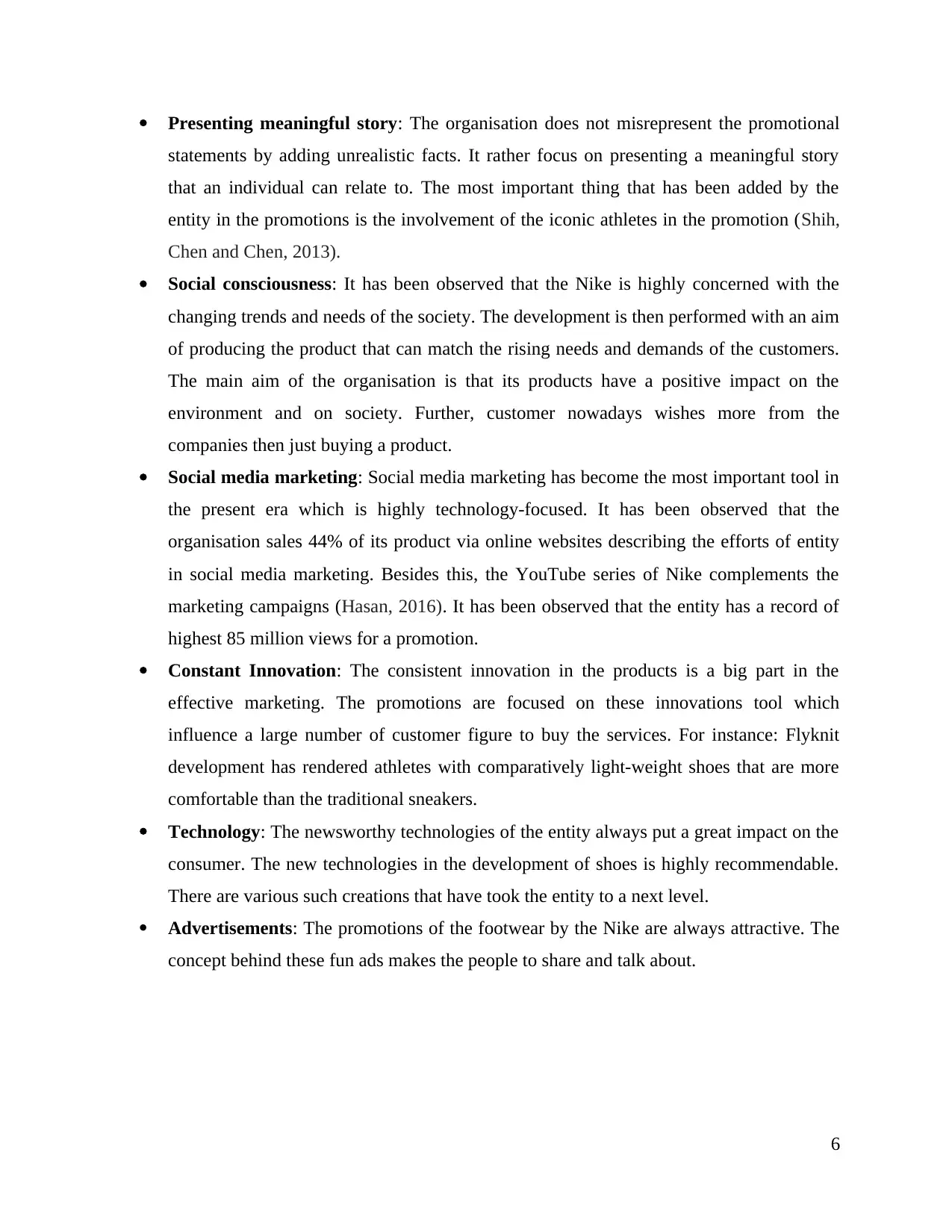
Presenting meaningful story: The organisation does not misrepresent the promotional
statements by adding unrealistic facts. It rather focus on presenting a meaningful story
that an individual can relate to. The most important thing that has been added by the
entity in the promotions is the involvement of the iconic athletes in the promotion (Shih,
Chen and Chen, 2013).
Social consciousness: It has been observed that the Nike is highly concerned with the
changing trends and needs of the society. The development is then performed with an aim
of producing the product that can match the rising needs and demands of the customers.
The main aim of the organisation is that its products have a positive impact on the
environment and on society. Further, customer nowadays wishes more from the
companies then just buying a product.
Social media marketing: Social media marketing has become the most important tool in
the present era which is highly technology-focused. It has been observed that the
organisation sales 44% of its product via online websites describing the efforts of entity
in social media marketing. Besides this, the YouTube series of Nike complements the
marketing campaigns (Hasan, 2016). It has been observed that the entity has a record of
highest 85 million views for a promotion.
Constant Innovation: The consistent innovation in the products is a big part in the
effective marketing. The promotions are focused on these innovations tool which
influence a large number of customer figure to buy the services. For instance: Flyknit
development has rendered athletes with comparatively light-weight shoes that are more
comfortable than the traditional sneakers.
Technology: The newsworthy technologies of the entity always put a great impact on the
consumer. The new technologies in the development of shoes is highly recommendable.
There are various such creations that have took the entity to a next level.
Advertisements: The promotions of the footwear by the Nike are always attractive. The
concept behind these fun ads makes the people to share and talk about.
6
statements by adding unrealistic facts. It rather focus on presenting a meaningful story
that an individual can relate to. The most important thing that has been added by the
entity in the promotions is the involvement of the iconic athletes in the promotion (Shih,
Chen and Chen, 2013).
Social consciousness: It has been observed that the Nike is highly concerned with the
changing trends and needs of the society. The development is then performed with an aim
of producing the product that can match the rising needs and demands of the customers.
The main aim of the organisation is that its products have a positive impact on the
environment and on society. Further, customer nowadays wishes more from the
companies then just buying a product.
Social media marketing: Social media marketing has become the most important tool in
the present era which is highly technology-focused. It has been observed that the
organisation sales 44% of its product via online websites describing the efforts of entity
in social media marketing. Besides this, the YouTube series of Nike complements the
marketing campaigns (Hasan, 2016). It has been observed that the entity has a record of
highest 85 million views for a promotion.
Constant Innovation: The consistent innovation in the products is a big part in the
effective marketing. The promotions are focused on these innovations tool which
influence a large number of customer figure to buy the services. For instance: Flyknit
development has rendered athletes with comparatively light-weight shoes that are more
comfortable than the traditional sneakers.
Technology: The newsworthy technologies of the entity always put a great impact on the
consumer. The new technologies in the development of shoes is highly recommendable.
There are various such creations that have took the entity to a next level.
Advertisements: The promotions of the footwear by the Nike are always attractive. The
concept behind these fun ads makes the people to share and talk about.
6
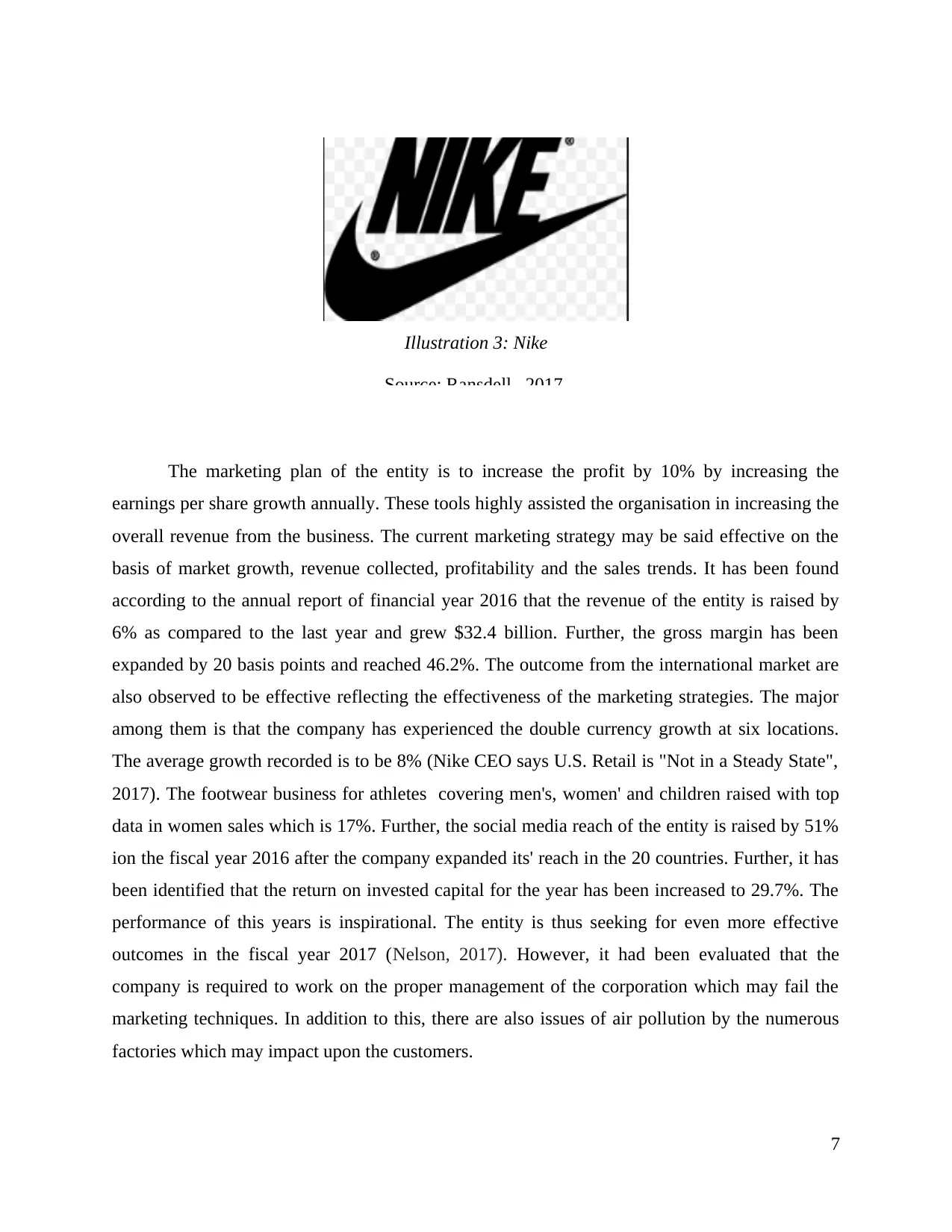
The marketing plan of the entity is to increase the profit by 10% by increasing the
earnings per share growth annually. These tools highly assisted the organisation in increasing the
overall revenue from the business. The current marketing strategy may be said effective on the
basis of market growth, revenue collected, profitability and the sales trends. It has been found
according to the annual report of financial year 2016 that the revenue of the entity is raised by
6% as compared to the last year and grew $32.4 billion. Further, the gross margin has been
expanded by 20 basis points and reached 46.2%. The outcome from the international market are
also observed to be effective reflecting the effectiveness of the marketing strategies. The major
among them is that the company has experienced the double currency growth at six locations.
The average growth recorded is to be 8% (Nike CEO says U.S. Retail is "Not in a Steady State",
2017). The footwear business for athletes covering men's, women' and children raised with top
data in women sales which is 17%. Further, the social media reach of the entity is raised by 51%
ion the fiscal year 2016 after the company expanded its' reach in the 20 countries. Further, it has
been identified that the return on invested capital for the year has been increased to 29.7%. The
performance of this years is inspirational. The entity is thus seeking for even more effective
outcomes in the fiscal year 2017 (Nelson, 2017). However, it had been evaluated that the
company is required to work on the proper management of the corporation which may fail the
marketing techniques. In addition to this, there are also issues of air pollution by the numerous
factories which may impact upon the customers.
7
Illustration 3: Nike
Source: Ransdell , 2017.
earnings per share growth annually. These tools highly assisted the organisation in increasing the
overall revenue from the business. The current marketing strategy may be said effective on the
basis of market growth, revenue collected, profitability and the sales trends. It has been found
according to the annual report of financial year 2016 that the revenue of the entity is raised by
6% as compared to the last year and grew $32.4 billion. Further, the gross margin has been
expanded by 20 basis points and reached 46.2%. The outcome from the international market are
also observed to be effective reflecting the effectiveness of the marketing strategies. The major
among them is that the company has experienced the double currency growth at six locations.
The average growth recorded is to be 8% (Nike CEO says U.S. Retail is "Not in a Steady State",
2017). The footwear business for athletes covering men's, women' and children raised with top
data in women sales which is 17%. Further, the social media reach of the entity is raised by 51%
ion the fiscal year 2016 after the company expanded its' reach in the 20 countries. Further, it has
been identified that the return on invested capital for the year has been increased to 29.7%. The
performance of this years is inspirational. The entity is thus seeking for even more effective
outcomes in the fiscal year 2017 (Nelson, 2017). However, it had been evaluated that the
company is required to work on the proper management of the corporation which may fail the
marketing techniques. In addition to this, there are also issues of air pollution by the numerous
factories which may impact upon the customers.
7
Illustration 3: Nike
Source: Ransdell , 2017.
⊘ This is a preview!⊘
Do you want full access?
Subscribe today to unlock all pages.

Trusted by 1+ million students worldwide
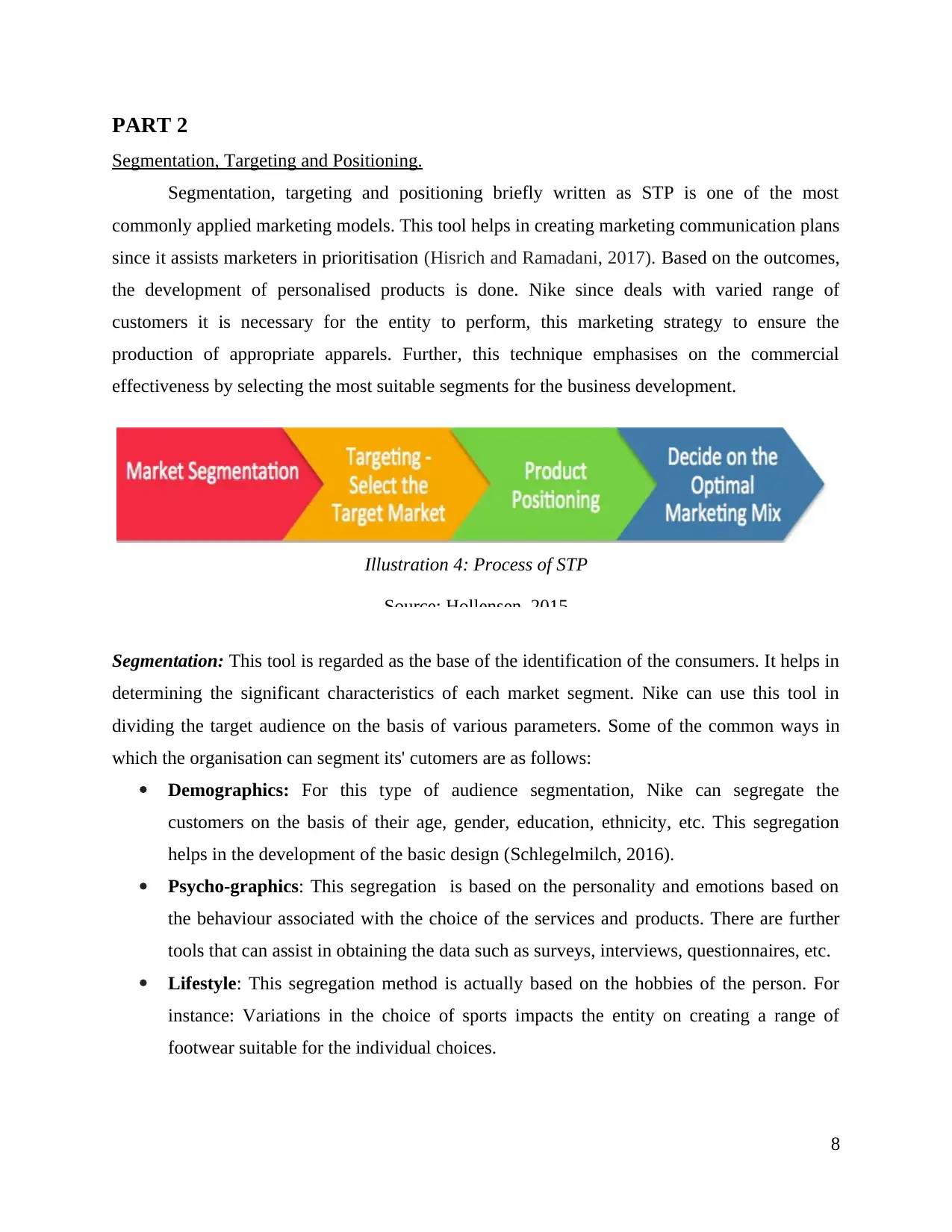
PART 2
Segmentation, Targeting and Positioning.
Segmentation, targeting and positioning briefly written as STP is one of the most
commonly applied marketing models. This tool helps in creating marketing communication plans
since it assists marketers in prioritisation (Hisrich and Ramadani, 2017). Based on the outcomes,
the development of personalised products is done. Nike since deals with varied range of
customers it is necessary for the entity to perform, this marketing strategy to ensure the
production of appropriate apparels. Further, this technique emphasises on the commercial
effectiveness by selecting the most suitable segments for the business development.
Segmentation: This tool is regarded as the base of the identification of the consumers. It helps in
determining the significant characteristics of each market segment. Nike can use this tool in
dividing the target audience on the basis of various parameters. Some of the common ways in
which the organisation can segment its' cutomers are as follows:
Demographics: For this type of audience segmentation, Nike can segregate the
customers on the basis of their age, gender, education, ethnicity, etc. This segregation
helps in the development of the basic design (Schlegelmilch, 2016).
Psycho-graphics: This segregation is based on the personality and emotions based on
the behaviour associated with the choice of the services and products. There are further
tools that can assist in obtaining the data such as surveys, interviews, questionnaires, etc.
Lifestyle: This segregation method is actually based on the hobbies of the person. For
instance: Variations in the choice of sports impacts the entity on creating a range of
footwear suitable for the individual choices.
8
Illustration 4: Process of STP
Source: Hollensen, 2015
Segmentation, Targeting and Positioning.
Segmentation, targeting and positioning briefly written as STP is one of the most
commonly applied marketing models. This tool helps in creating marketing communication plans
since it assists marketers in prioritisation (Hisrich and Ramadani, 2017). Based on the outcomes,
the development of personalised products is done. Nike since deals with varied range of
customers it is necessary for the entity to perform, this marketing strategy to ensure the
production of appropriate apparels. Further, this technique emphasises on the commercial
effectiveness by selecting the most suitable segments for the business development.
Segmentation: This tool is regarded as the base of the identification of the consumers. It helps in
determining the significant characteristics of each market segment. Nike can use this tool in
dividing the target audience on the basis of various parameters. Some of the common ways in
which the organisation can segment its' cutomers are as follows:
Demographics: For this type of audience segmentation, Nike can segregate the
customers on the basis of their age, gender, education, ethnicity, etc. This segregation
helps in the development of the basic design (Schlegelmilch, 2016).
Psycho-graphics: This segregation is based on the personality and emotions based on
the behaviour associated with the choice of the services and products. There are further
tools that can assist in obtaining the data such as surveys, interviews, questionnaires, etc.
Lifestyle: This segregation method is actually based on the hobbies of the person. For
instance: Variations in the choice of sports impacts the entity on creating a range of
footwear suitable for the individual choices.
8
Illustration 4: Process of STP
Source: Hollensen, 2015
Paraphrase This Document
Need a fresh take? Get an instant paraphrase of this document with our AI Paraphraser
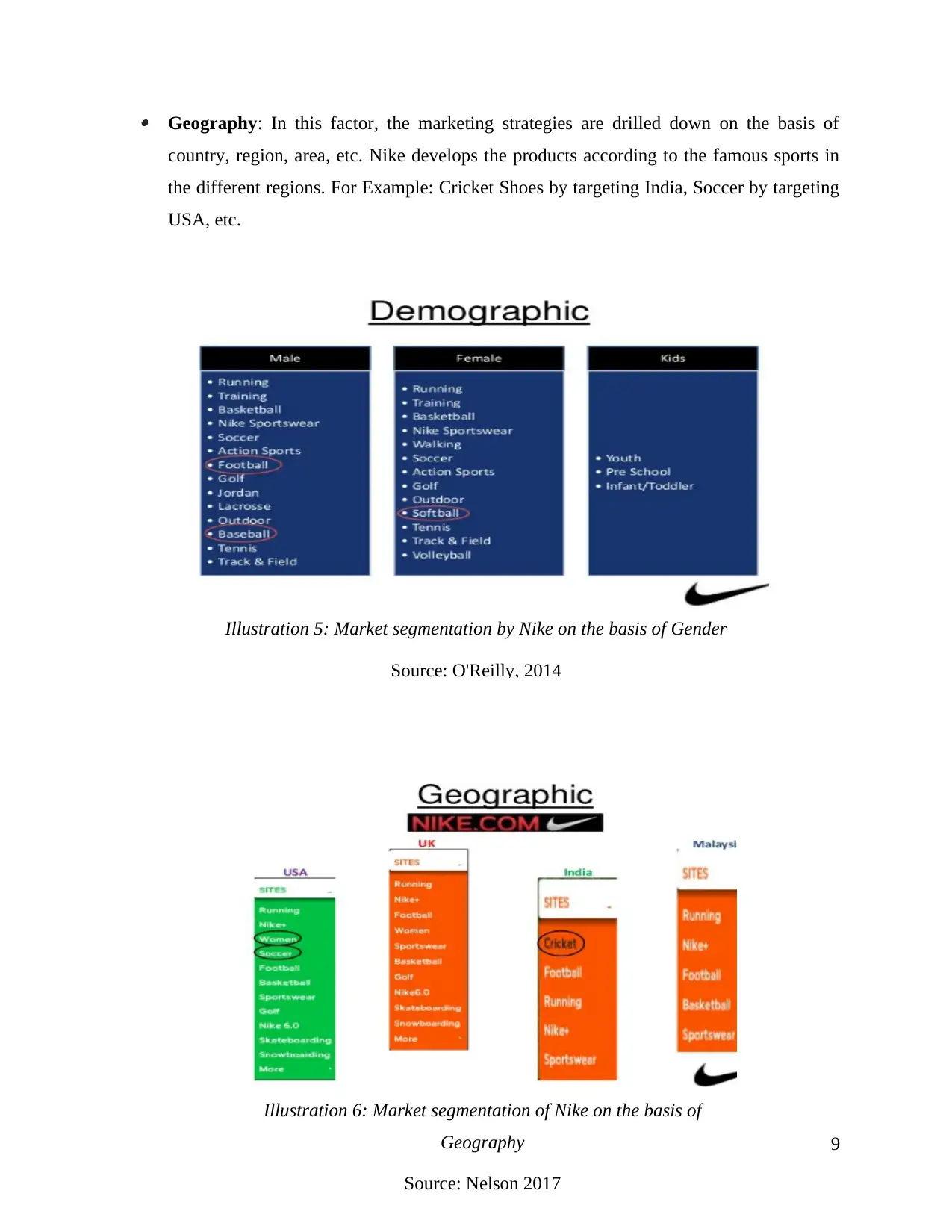
Geography: In this factor, the marketing strategies are drilled down on the basis of
country, region, area, etc. Nike develops the products according to the famous sports in
the different regions. For Example: Cricket Shoes by targeting India, Soccer by targeting
USA, etc.
9
Illustration 5: Market segmentation by Nike on the basis of Gender
Source: O'Reilly, 2014
Illustration 6: Market segmentation of Nike on the basis of
Geography
Source: Nelson 2017
country, region, area, etc. Nike develops the products according to the famous sports in
the different regions. For Example: Cricket Shoes by targeting India, Soccer by targeting
USA, etc.
9
Illustration 5: Market segmentation by Nike on the basis of Gender
Source: O'Reilly, 2014
Illustration 6: Market segmentation of Nike on the basis of
Geography
Source: Nelson 2017
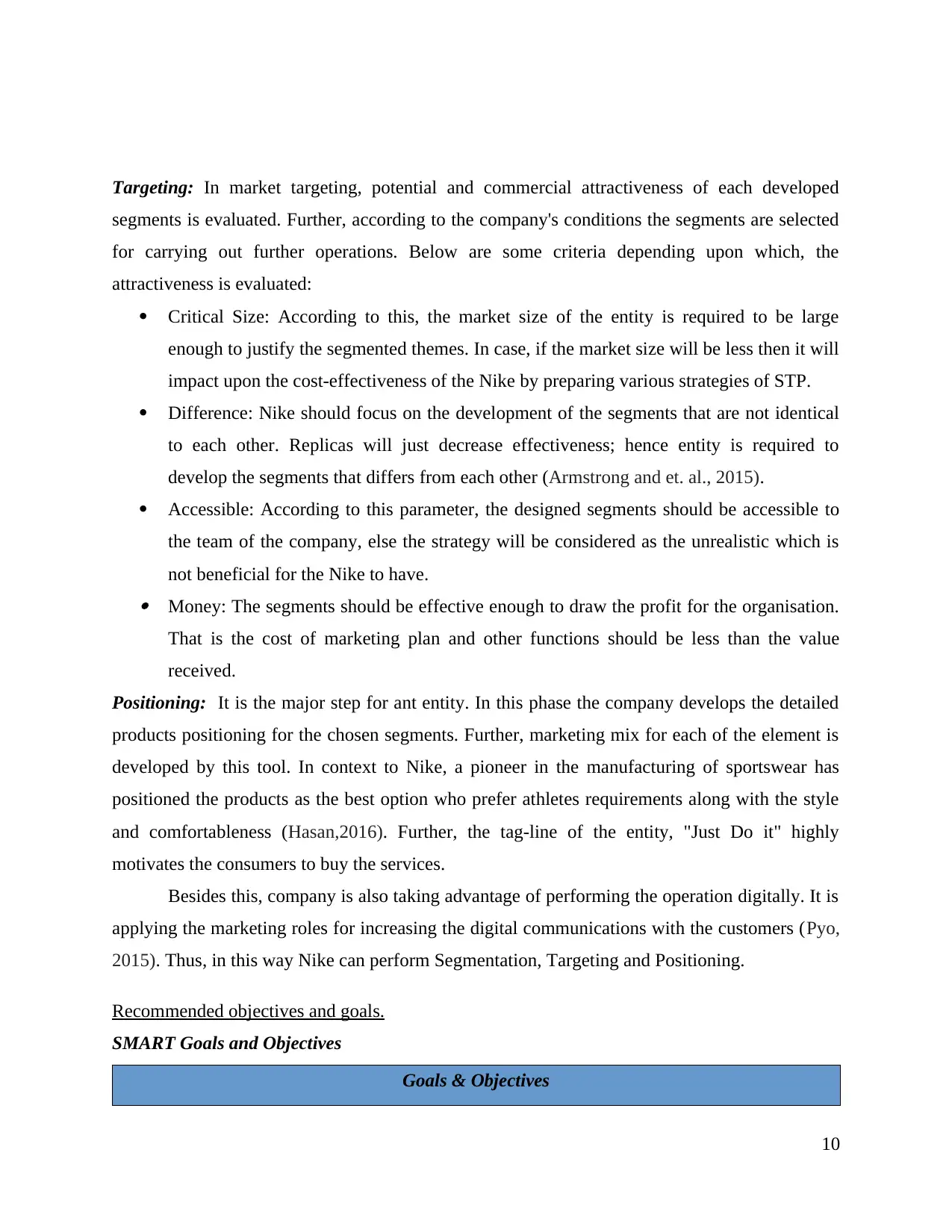
Targeting: In market targeting, potential and commercial attractiveness of each developed
segments is evaluated. Further, according to the company's conditions the segments are selected
for carrying out further operations. Below are some criteria depending upon which, the
attractiveness is evaluated:
Critical Size: According to this, the market size of the entity is required to be large
enough to justify the segmented themes. In case, if the market size will be less then it will
impact upon the cost-effectiveness of the Nike by preparing various strategies of STP.
Difference: Nike should focus on the development of the segments that are not identical
to each other. Replicas will just decrease effectiveness; hence entity is required to
develop the segments that differs from each other (Armstrong and et. al., 2015).
Accessible: According to this parameter, the designed segments should be accessible to
the team of the company, else the strategy will be considered as the unrealistic which is
not beneficial for the Nike to have. Money: The segments should be effective enough to draw the profit for the organisation.
That is the cost of marketing plan and other functions should be less than the value
received.
Positioning: It is the major step for ant entity. In this phase the company develops the detailed
products positioning for the chosen segments. Further, marketing mix for each of the element is
developed by this tool. In context to Nike, a pioneer in the manufacturing of sportswear has
positioned the products as the best option who prefer athletes requirements along with the style
and comfortableness (Hasan,2016). Further, the tag-line of the entity, "Just Do it" highly
motivates the consumers to buy the services.
Besides this, company is also taking advantage of performing the operation digitally. It is
applying the marketing roles for increasing the digital communications with the customers (Pyo,
2015). Thus, in this way Nike can perform Segmentation, Targeting and Positioning.
Recommended objectives and goals.
SMART Goals and Objectives
Goals & Objectives
10
segments is evaluated. Further, according to the company's conditions the segments are selected
for carrying out further operations. Below are some criteria depending upon which, the
attractiveness is evaluated:
Critical Size: According to this, the market size of the entity is required to be large
enough to justify the segmented themes. In case, if the market size will be less then it will
impact upon the cost-effectiveness of the Nike by preparing various strategies of STP.
Difference: Nike should focus on the development of the segments that are not identical
to each other. Replicas will just decrease effectiveness; hence entity is required to
develop the segments that differs from each other (Armstrong and et. al., 2015).
Accessible: According to this parameter, the designed segments should be accessible to
the team of the company, else the strategy will be considered as the unrealistic which is
not beneficial for the Nike to have. Money: The segments should be effective enough to draw the profit for the organisation.
That is the cost of marketing plan and other functions should be less than the value
received.
Positioning: It is the major step for ant entity. In this phase the company develops the detailed
products positioning for the chosen segments. Further, marketing mix for each of the element is
developed by this tool. In context to Nike, a pioneer in the manufacturing of sportswear has
positioned the products as the best option who prefer athletes requirements along with the style
and comfortableness (Hasan,2016). Further, the tag-line of the entity, "Just Do it" highly
motivates the consumers to buy the services.
Besides this, company is also taking advantage of performing the operation digitally. It is
applying the marketing roles for increasing the digital communications with the customers (Pyo,
2015). Thus, in this way Nike can perform Segmentation, Targeting and Positioning.
Recommended objectives and goals.
SMART Goals and Objectives
Goals & Objectives
10
⊘ This is a preview!⊘
Do you want full access?
Subscribe today to unlock all pages.

Trusted by 1+ million students worldwide
1 out of 18
Related Documents
Your All-in-One AI-Powered Toolkit for Academic Success.
+13062052269
info@desklib.com
Available 24*7 on WhatsApp / Email
![[object Object]](/_next/static/media/star-bottom.7253800d.svg)
Unlock your academic potential
Copyright © 2020–2025 A2Z Services. All Rights Reserved. Developed and managed by ZUCOL.





